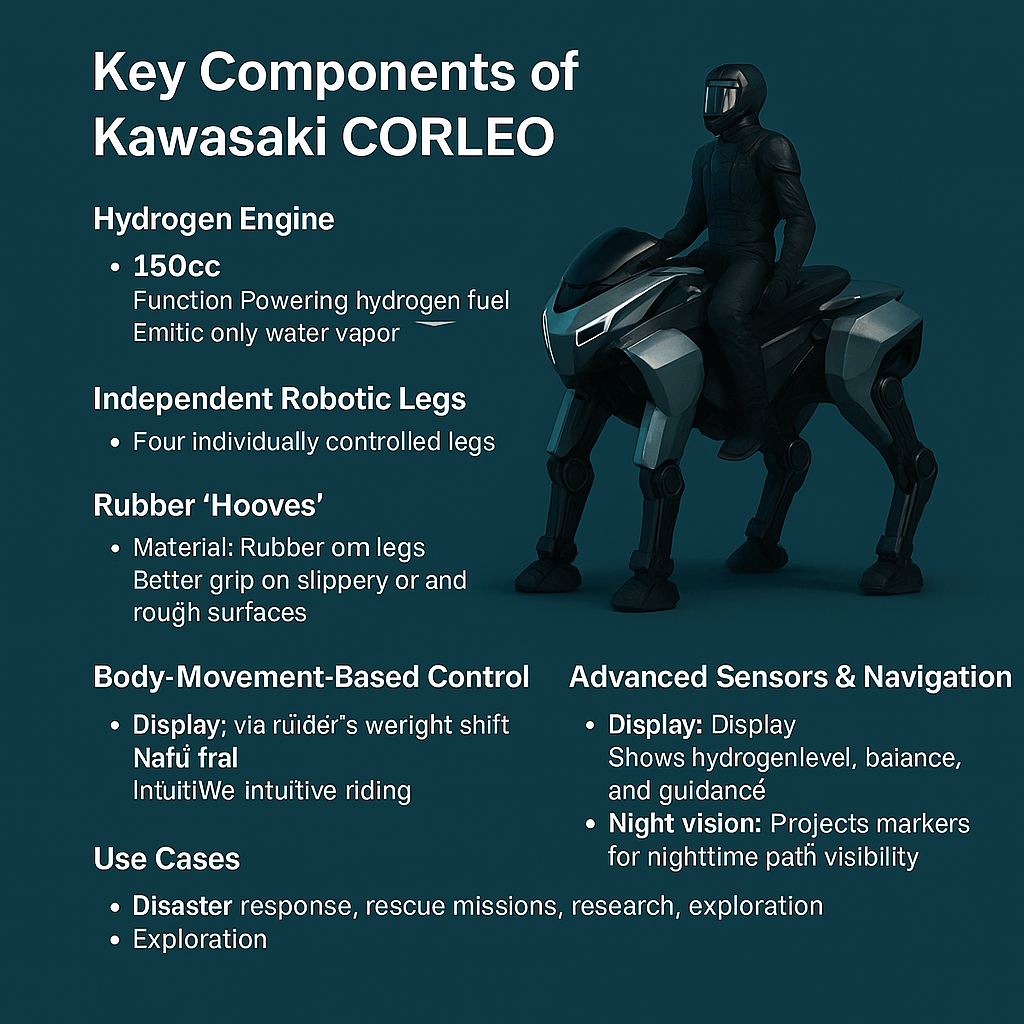
Kawasaki CORLEO: The Four-Legged Rideable Robot
Day 273 of Tech Coverage — What Happened in Tech in the Last 24 Hours
Kawasaki, a name historically linked to high-performance motorcycles and industrial machines, has taken a bold step into futuristic mobility with the unveiling of CORLEO, a four-legged concept robot designed for humans to ride. This announcement isn’t just about a new piece of tech—it hints at a shift in how we might interact with machines in real life, beyond the factory and into daily environments.
Let’s dive into the complete details about Kawasaki CORLEO: from its origin and technological inspiration to its practical applications, how it works, and what the future might hold.
What is Kawasaki CORLEO?
CORLEO is a quadruped (four-legged) robotic concept developed by Kawasaki Heavy Industries, designed with one unique feature: humans can ride it.
Unlike Boston Dynamics’ Spot or other similar quadruped robots, CORLEO is not just an autonomous machine—it’s intended for human-robot symbiosis in real-time.
The History & Evolution of CORLEO
Kawasaki began its exploration of bipedal and quadrupedal robotics around 2015, with the goal of pushing the boundaries of mobility beyond wheels.
Timeline:
- 2015–2019: Kawasaki’s robotics division starts working on bipedal robots for industrial automation.
- 2020: They begin experimenting with quadrupedal motion, taking inspiration from animals and exoskeleton tech.
- 2021: Project BEX is introduced—a quadruped with wheels used for cargo transport.
- 2024–2025: CORLEO is revealed—a quadruped with full human-carrying capability, stable motion, and ergonomic rider support.
- CORLEO is a natural evolution from BEX, combining the strength of industrial robotics with AI-powered movement coordination.

How CORLEO Works: The Technology Behind It
CORLEO operates using a combination of artificial intelligence, sensor fusion, and robotic actuators. Its four-legged structure enables it to maintain dynamic balance on uneven terrains.
Key Features:
- Quadruped Legs: Each leg is independently powered and moves with precision.
Rider Interface: A seat and handle system allows a human to mount and control (or co-pilot) the robot.
Sensors & AI: LIDAR, gyroscopes, and motion sensors feed into a central AI processor that adjusts posture and steps.
Energy Source: It likely uses a battery-powered motor system, similar to electric bikes or EVs.
Use Cases of Kawasaki CORLEO
CORLEO may look futuristic, but its potential uses are practical and diverse:
1. Disaster Relief and Rescue
- Can carry a person or supplies across rough or dangerous terrain.
Ideal for search & rescue missions where wheeled vehicles can’t reach.
2. Remote Patrol and Surveillance
With mounted cameras and sensors, it can act as a mobile watchtower.
Especially useful in defense, wildlife reserves, or border patrols.
3. Healthcare & Assisted Mobility
Potential to assist the elderly or disabled in navigating hilly or uneven spaces.
4. Entertainment and Theme Parks
- Could become part of futuristic rides or interactive robots in theme parks or events.
5. Agriculture & Construction
- Replace traditional transport in fields, farms, or construction sites where mud and elevation make normal vehicles inefficient.
Comparison With Other Quadruped Robots
| Feature | CORELO by Kawasaki | Spot by Boston Dynamics | ANYmal by ANYbotics |
|---|---|---|---|
| Can carry human | ✅ Yes | ❌NO | ❌NO |
| Terrain navigation | ✅ Yes | ✅ Yes | ✅ Yes |
| Industrial usage | ✅ Expected | ✅ Yes | ✅ Yes |
| Entertainment use | ✅ Possible | ❌NO | ❌NO |
What’s the Future of CORLEO and Rideable Robots?
Kawasaki hasn’t announced a release date or price, but this concept opens the door to a new category of machines: Personal Mobility Robots.
Future Possibilities:
Autonomous Riding Mode – Users could be carried without any control input.
Connected Systems – CORLEO could be linked to smart cities, where it picks you up like an Uber.
Battery + Solar Hybrid Models – For sustainability in rural or off-grid regions.
Military and Defense Contracts – CORLEO could become part of exosuit-integrated missions or robotic support troops.
Why CORLEO Matters for the Future of Mobility
Kawasaki’s CORLEO isn’t just about cool tech—it’s a glimpse into a future where machines help humans move, work, and survive in places we couldn’t otherwise go.
This rideable quadruped could:
Replace ATVs in remote areas.
Help the disabled or elderly gain independent mobility.
Become a vital tool in emergency response efforts.
🚨 CORLEO isn’t just science fiction—it’s practical science in motion.
External Resources
Related keywords:
Kawasaki CORLEO robot, rideable robot by Kawasaki, four-legged robot for humans, futuristic mobility robot, CORLEO robot features, robot that humans can ride, Kawasaki robotic mobility, quadruped robot with human interface, Kawasaki 2025 robot launch, CORLEO vs Boston Dynamics, Kawasaki BEX vs CORLEO.
Conclusion:
With CORLEO, Kawasaki proves it’s not just a motorcycle company—but a futuristic mobility pioneer. As robots begin walking beside us (literally), CORLEO could mark the beginning of a new era of rideable robotics.
Let us know—Would you ride CORLEO if it launched today?
👇 Drop your thoughts in the comments.
